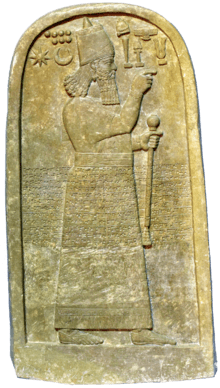Ashur-nirari I
Aššur-nārāri I, inscribed maš-šur-ERIM.GABA, "Aššur is my help," was an Old Assyrian king who ruled for 26 years during the mid-second millennium BC, speculatively ca. 1534–1509 (Landsberger) or 1523–1499 BC (Gasche). He was the 60th king to be listed on the Assyrian Kinglist and expanded the titles adopted by Assyrian rulers to include muddiš, "restorer of," and bāni, "builder of," to the traditional epithets ensi, "governor," and iššiak, "vice-regent," of Aššur.[1]
| Ashur-nirari I | |
|---|---|
| King of Assyria | |
| King of the Old Assyrian Empire | |
| Reign | 1529–1503 BC |
| Predecessor | Shamshi-Adad III |
| Successor | Puzur-Ashur III |
| Issue | Puzur-Ashur III |
| Father | Ishme-Dagan |
Biography
He was the son of Išme-Dagān II, and succeeded his brother Šamši-Adad III to the throne, ruling for twenty six years, an identification that all three Assyrian Kinglists (Khorsabad,[i 1] SDAS[i 2] and Nassouhi[i 3]) agree on.[2] The Synchronistic Kinglist[i 4] gives his Babylonian contemporary as Kaštil[...], possibly identified as Kaštiliašu III, the son and (eventual) successor of Burna-Buriyåš I, the Kassite kings of Babylon during the period when the dynasty was beginning to exert control over southern Mesopotamia.
Evidence of his construction activities survives, with four short inscriptions commemorating work building the temple of Bel-ibrīia on bricks recovered from an old ravine, restoring the Abaru forecourt and rebuilding the Sîn-Šamaš (Moon-god/Sun-god) temple,[3] called the é.ḫúl.ḫúl.dir.dir.ra, “House of Surpassing Joys,” which would be later restored by Tukulti-Ninurta I and Aššur-nāṣir-apli II.[4] He ruled in a peaceful and uneventful period of Assyrian history following the overthrow of the Babylonians and Amorites by Puzur-Sin c. 1732 BC and the rise of the Mitanni in the 1450s BC. He was succeeded by his son Puzur-Aššur III.
Inscriptions
- Khorsabad Kinglist, tablet IM 60017 (excavation nos.: DS 828, DS 32-54) ii 36.
- SDAS Kinglist, tablet IM 60484, ii 28.
- Nassouhi Kinglist, Istanbul A. 116 (Assur 8836), ii 32.
- Synchronistic Kinglist, Ass 14616c, KAV 216, i 21.
References
- Barbara Cifola (1995). Analysis of variants in the Assyrian royal titulary from the origins to Tiglath-Pileser III. Istituto universitario orientale. p. 18.
- A. Fuchs, K. Radner (1998). "Aššur-nerari". In K. Radner (ed.). The Prosopography of the Neo-Assyrian Empire, Volume 1, Part I: A. The Neo-Assyrian Text Corpus Project. p. 208.
- A. K. Grayson (1972). Assyrian Royal Inscriptions, Volume 1. Otto Harrassowitz. pp. 33–34.
- A. R. George (1993). House Most High: The Temples of Ancient Mesopotamia. Eisenbrauns. p. 100.
| Preceded by Šamši-Adad III |
King of Assyria 1534–1509 BC |
Succeeded by Puzur-Aššur III |
